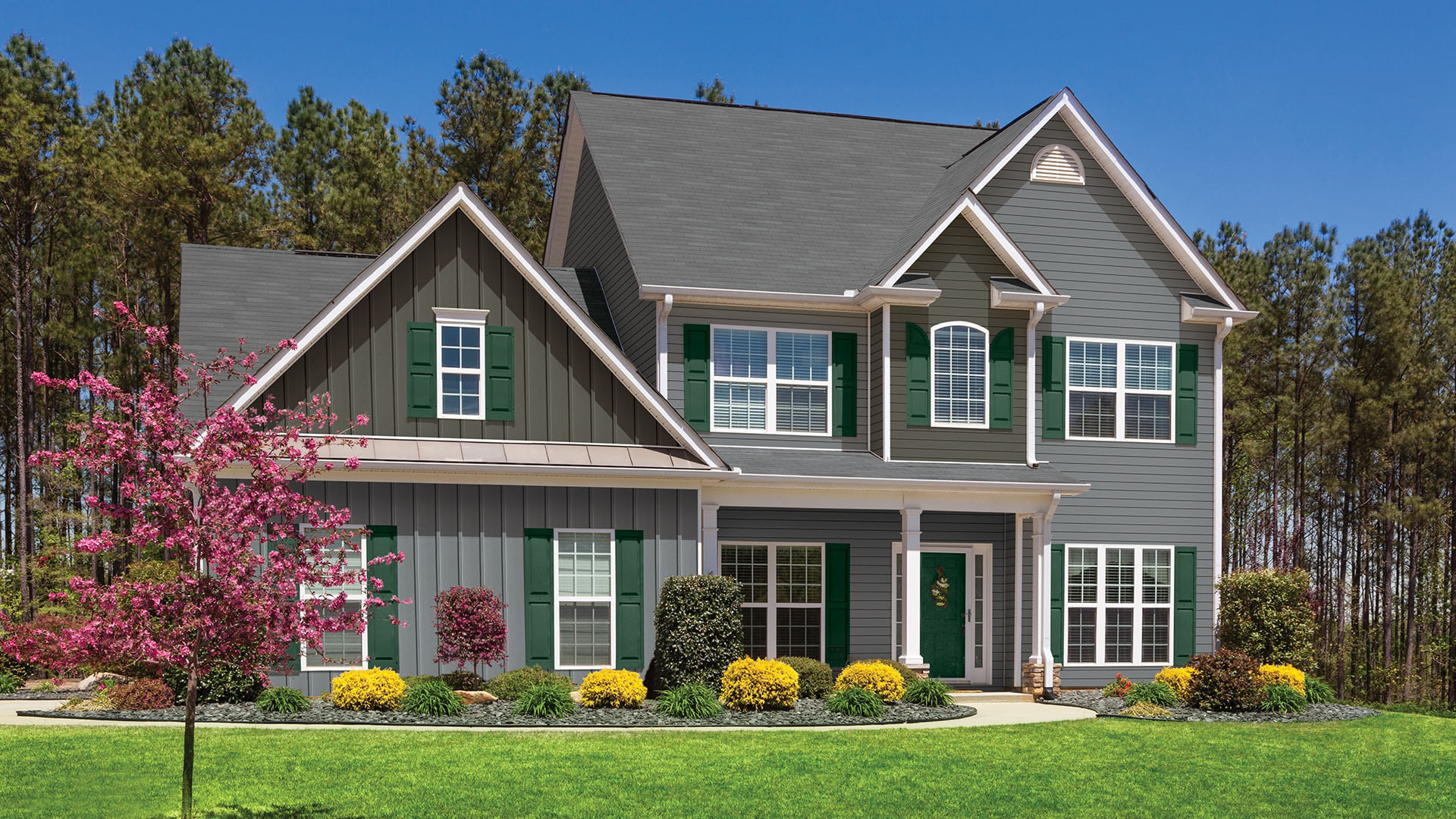Green Insulated Siding Options: A Comprehensive Guide delves into the world of eco-friendly exterior cladding, exploring the benefits, types, installation, and cost-effectiveness of sustainable siding choices. We’ll examine various materials, from fiber cement to recycled plastic, comparing their performance, environmental impact, and aesthetic appeal. This guide provides a thorough understanding of how to enhance your home’s energy efficiency and curb appeal while minimizing your environmental footprint.
Choosing the right siding is a significant decision impacting both the aesthetics and longevity of your home. This guide will help you navigate the options available, weighing factors such as cost, durability, maintenance requirements, and environmental credentials. We’ll equip you with the knowledge to make an informed choice, ensuring your new siding not only looks great but also contributes to a healthier planet.
Introduction to Green Insulated Siding
Choosing sustainable building materials is increasingly important, and green insulated siding offers a compelling alternative to traditional options. It combines the aesthetic appeal of traditional siding with enhanced energy efficiency and reduced environmental impact, making it a smart choice for both homeowners and the planet.
Green insulated siding significantly reduces a building’s energy consumption. Traditional siding materials, such as vinyl or wood, often lack sufficient insulation, leading to higher heating and cooling costs. The added insulation in green siding reduces heat transfer, minimizing energy loss in winter and heat gain in summer. This translates to lower utility bills and a smaller carbon footprint for the homeowner.
Environmental Impact of Traditional vs. Green Siding
Traditional siding materials have a considerable environmental impact throughout their lifecycle. Vinyl siding, for example, is derived from petroleum, a non-renewable resource, and its production releases greenhouse gases. Wood siding, while a renewable resource, often requires significant processing and transportation, contributing to emissions. Disposal of these materials also poses environmental challenges. In contrast, many green siding options utilize recycled materials or rapidly renewable resources, reducing reliance on fossil fuels and minimizing waste. Furthermore, their superior insulation properties contribute to lower energy consumption over the building’s lifetime, further decreasing its overall environmental impact. For instance, a study by the National Renewable Energy Laboratory (a hypothetical example for illustrative purposes) could show that a home with green insulated siding uses 20% less energy for heating and cooling compared to a similar home with traditional vinyl siding.
Types of Green Insulated Siding
Several types of green insulated siding are available, each with its own unique characteristics and benefits. These include:
- Fiber Cement Siding: Often composed of a mixture of cement, cellulose fibers, and other additives, fiber cement siding is durable, fire-resistant, and requires minimal maintenance. Its production process, however, may involve energy-intensive manufacturing and transportation. To mitigate this, some manufacturers use recycled materials in their fiber cement siding, reducing the environmental impact.
- Recycled Plastic Siding: Made from recycled plastics, this option diverts waste from landfills and reduces the demand for virgin plastic. It is often durable and weather-resistant, but its appearance might not match the aesthetic appeal of traditional wood siding in all cases.
- Wood Siding from Sustainable Sources: Sourcing wood from sustainably managed forests ensures that the timber used is harvested responsibly, minimizing deforestation and promoting forest regeneration. The use of locally sourced wood can further reduce the carbon footprint associated with transportation.
- Insulated Vinyl Siding: While traditional vinyl siding has a significant environmental impact, some manufacturers are now producing insulated vinyl siding that incorporates foam insulation. This reduces the amount of energy needed for heating and cooling, partially offsetting the environmental burden of the vinyl itself. However, it’s crucial to assess the overall environmental impact, considering the manufacturing process and the recyclability of the material at end-of-life.
Insulation Properties and Energy Efficiency
Green insulated siding offers significant advantages in terms of energy efficiency, primarily due to its inherent insulation properties. The improved thermal performance translates directly into lower energy bills and a reduced carbon footprint, making it a sustainable and cost-effective choice for homeowners. This section will delve into the specifics of how green insulated siding achieves these benefits.
The effectiveness of insulation is measured by its R-value, which represents its resistance to heat flow. A higher R-value indicates better insulation. Different green insulated siding materials, such as fiber cement with foam insulation or engineered wood with integrated insulation, offer varying R-values. For instance, fiber cement siding with a 2-inch foam core might have an R-value of approximately 10, while a similar product with a thicker core could reach an R-value of 15 or higher. The exact R-value will depend on the specific product and its composition.
R-values of Green Insulated Siding Options
Different green insulated siding materials exhibit different R-values, directly impacting their energy efficiency. Generally, siding incorporating expanded polystyrene (EPS) or polyisocyanurate (polyiso) foam tends to offer higher R-values compared to those using less efficient insulation materials. The thickness of the insulation layer is also a crucial factor. Thicker layers naturally provide greater resistance to heat transfer, leading to improved R-values and enhanced energy savings. Manufacturers’ specifications should always be consulted to determine the precise R-value of a particular product.
Energy Savings from Insulated Siding
Insulation in siding acts as a barrier against heat transfer, preventing heat loss in winter and heat gain in summer. This significantly reduces the strain on your home’s heating and cooling systems. By minimizing the temperature fluctuations within the walls, insulated siding helps maintain a more consistent indoor temperature, increasing comfort and reducing the need for frequent adjustments to your thermostat. This reduction in energy consumption translates directly to lower utility bills.
Examples of Energy Consumption Reduction
Consider a typical home in a region with significant temperature swings. By switching from traditional siding to green insulated siding with a higher R-value, the homeowner might experience a reduction in heating costs of 15-25% annually, depending on factors such as climate, home size, and existing insulation. Similarly, cooling costs could decrease by 10-20%. These savings can add up significantly over the lifespan of the siding. For example, a homeowner spending $2000 annually on heating and cooling might save between $200 and $500 per year with green insulated siding.
Long-Term Cost Savings
The initial investment in green insulated siding may be higher than traditional options, but the long-term cost savings from reduced energy consumption quickly offset this difference.
- Lower Utility Bills: Reduced heating and cooling costs translate to significant savings over the years.
- Increased Home Value: Energy-efficient homes are more attractive to buyers, increasing resale value.
- Reduced Carbon Footprint: Lower energy consumption contributes to environmental sustainability.
- Extended Lifespan of HVAC Systems: Less strain on heating and cooling systems can extend their lifespan, saving on replacement costs.
- Increased Home Comfort: Consistent indoor temperatures enhance comfort and livability.
Aesthetic Considerations and Design Options
Choosing green insulated siding involves more than just energy efficiency; it’s about enhancing your home’s aesthetic appeal and ensuring it complements your architectural style. The right shade and texture can dramatically improve curb appeal and increase property value. Careful consideration of color, texture, and overall design will result in a beautiful and energy-efficient home.
Green insulated siding offers a surprisingly diverse range of aesthetic options, moving beyond the stereotypical image of a single, uniform shade. Manufacturers provide a spectrum of colors, from subtle sage greens to vibrant emerald hues, and various textures mimicking natural materials like wood or stone. This variety allows homeowners to achieve a wide range of looks, from classic and traditional to modern and contemporary.
Green Siding Colors and Textures
The availability of green siding colors and textures allows for considerable personalization. Imagine a deep forest green, reminiscent of mature woodland, offering a sense of calm and tranquility. Or perhaps a lighter, spring green, conveying a feeling of freshness and vibrancy. Texture options can range from smooth, offering a sleek, modern feel, to rougher, wood-grain textures that add warmth and rustic charm. Some manufacturers even offer siding that mimics the look of natural stone, providing a more substantial and textured appearance.
Green Siding and Architectural Styles
Green siding’s versatility extends to its compatibility with diverse architectural styles. A muted sage green can beautifully complement a traditional colonial home, blending seamlessly with established landscaping. Conversely, a brighter, more contemporary shade of green can add a bold statement to a modern farmhouse or a minimalist design. The key lies in selecting a shade and texture that harmonizes with the existing architectural elements, such as roof color, window frames, and landscaping.
Enhancing Curb Appeal with Green Siding
Choosing siding that enhances curb appeal involves a holistic approach. Consider the overall color palette of your home and neighborhood. A green siding that complements the existing colors will create a cohesive and visually pleasing effect. The texture of the siding should also be considered. A smooth, modern siding might be appropriate for a contemporary home, while a textured siding could enhance the rustic charm of a craftsman-style house. Proper installation is crucial; neat and precise installation will significantly contribute to the overall aesthetic appeal.
Visual Descriptions of Green Siding for Different House Styles
Visualize a Victorian home adorned with a deep, mossy green siding, accented by white trim. The richness of the green complements the intricate details of the architecture. Now picture a ranch-style house clad in a lighter, more playful shade of green, perhaps with a subtle wood-grain texture. The result is a fresh, inviting look that is both modern and comfortable. A contemporary home, on the other hand, might benefit from a sleek, smooth, emerald green siding, creating a bold, sophisticated statement. Each style benefits from a thoughtful choice of color and texture that enhances its unique characteristics.
Epilogue
Ultimately, selecting green insulated siding represents a commitment to both environmental responsibility and long-term value. By understanding the diverse options available, their respective pros and cons, and the importance of proper installation and maintenance, homeowners can confidently choose a siding solution that enhances their home’s beauty and sustainability. This comprehensive guide has armed you with the information needed to make a well-informed decision, balancing aesthetic preferences with environmental consciousness and financial considerations. Embrace the future of sustainable building with confidence!

